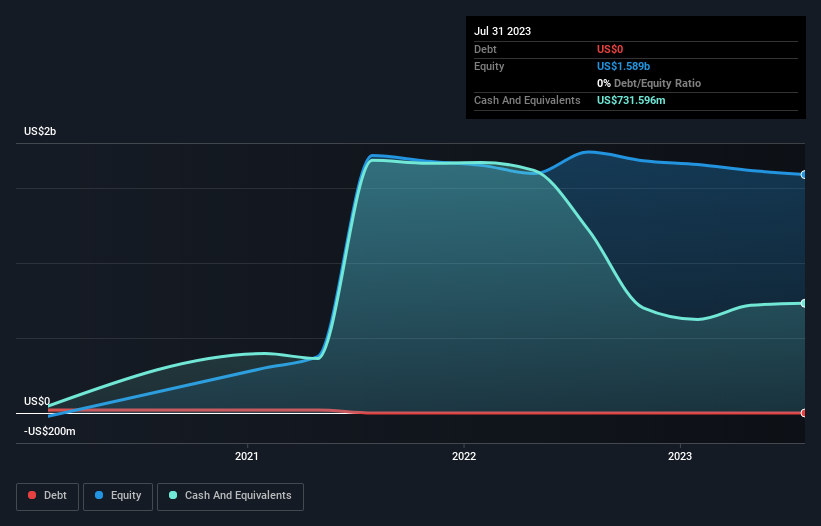- United States
- /
- Software
- /
- NYSE:S
Here's Why We're Not At All Concerned With SentinelOne's (NYSE:S) Cash Burn Situation

We can readily understand why investors are attracted to unprofitable companies. For example, although software-as-a-service business Salesforce.com lost money for years while it grew recurring revenue, if you held shares since 2005, you'd have done very well indeed. But the harsh reality is that very many loss making companies burn through all their cash and go bankrupt.
Given this risk, we thought we'd take a look at whether SentinelOne (NYSE:S) shareholders should be worried about its cash burn. For the purposes of this article, cash burn is the annual rate at which an unprofitable company spends cash to fund its growth; its negative free cash flow. We'll start by comparing its cash burn with its cash reserves in order to calculate its cash runway.
View our latest analysis for SentinelOne
How Long Is SentinelOne's Cash Runway?
A company's cash runway is calculated by dividing its cash hoard by its cash burn. As at July 2023, SentinelOne had cash of US$732m and no debt. Importantly, its cash burn was US$137m over the trailing twelve months. That means it had a cash runway of about 5.3 years as of July 2023. Notably, however, analysts think that SentinelOne will break even (at a free cash flow level) before then. In that case, it may never reach the end of its cash runway. Depicted below, you can see how its cash holdings have changed over time.

How Well Is SentinelOne Growing?
On balance, we think it's mildly positive that SentinelOne trimmed its cash burn by 8.8% over the last twelve months. And arguably the operating revenue growth of 73% was even more impressive. It seems to be growing nicely. Clearly, however, the crucial factor is whether the company will grow its business going forward. For that reason, it makes a lot of sense to take a look at our analyst forecasts for the company.
How Hard Would It Be For SentinelOne To Raise More Cash For Growth?
While SentinelOne seems to be in a decent position, we reckon it is still worth thinking about how easily it could raise more cash, if that proved desirable. Companies can raise capital through either debt or equity. Many companies end up issuing new shares to fund future growth. By looking at a company's cash burn relative to its market capitalisation, we gain insight on how much shareholders would be diluted if the company needed to raise enough cash to cover another year's cash burn.
SentinelOne has a market capitalisation of US$4.8b and burnt through US$137m last year, which is 2.9% of the company's market value. That means it could easily issue a few shares to fund more growth, and might well be in a position to borrow cheaply.
Is SentinelOne's Cash Burn A Worry?
It may already be apparent to you that we're relatively comfortable with the way SentinelOne is burning through its cash. For example, we think its revenue growth suggests that the company is on a good path. On this analysis its cash burn reduction was its weakest feature, but we are not concerned about it. There's no doubt that shareholders can take a lot of heart from the fact that analysts are forecasting it will reach breakeven before too long. After considering a range of factors in this article, we're pretty relaxed about its cash burn, since the company seems to be in a good position to continue to fund its growth. Taking an in-depth view of risks, we've identified 3 warning signs for SentinelOne that you should be aware of before investing.
Of course SentinelOne may not be the best stock to buy. So you may wish to see this free collection of companies boasting high return on equity, or this list of stocks that insiders are buying.
If you're looking to trade SentinelOne, open an account with the lowest-cost platform trusted by professionals, Interactive Brokers.
With clients in over 200 countries and territories, and access to 160 markets, IBKR lets you trade stocks, options, futures, forex, bonds and funds from a single integrated account.
Enjoy no hidden fees, no account minimums, and FX conversion rates as low as 0.03%, far better than what most brokers offer.
Sponsored ContentNew: Manage All Your Stock Portfolios in One Place
We've created the ultimate portfolio companion for stock investors, and it's free.
• Connect an unlimited number of Portfolios and see your total in one currency
• Be alerted to new Warning Signs or Risks via email or mobile
• Track the Fair Value of your stocks
Have feedback on this article? Concerned about the content? Get in touch with us directly. Alternatively, email editorial-team (at) simplywallst.com.
This article by Simply Wall St is general in nature. We provide commentary based on historical data and analyst forecasts only using an unbiased methodology and our articles are not intended to be financial advice. It does not constitute a recommendation to buy or sell any stock, and does not take account of your objectives, or your financial situation. We aim to bring you long-term focused analysis driven by fundamental data. Note that our analysis may not factor in the latest price-sensitive company announcements or qualitative material. Simply Wall St has no position in any stocks mentioned.
About NYSE:S
SentinelOne
Operates as a cybersecurity provider in the United States and internationally.
Flawless balance sheet and fair value.
Similar Companies
Market Insights
Community Narratives



